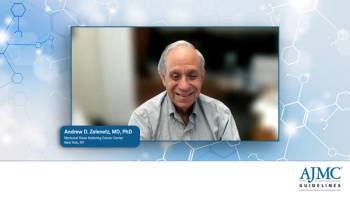
Review: Venetoclax Plus HMAs Offer “Moderate” Benefit in AML/MDS After Relapse Post Transplant
There is no standard treatment in acute myeloid leukemia (AML) or myelodysplastic syndromes (MDS) for patients who have a relapse following allogeneic hematopoietic cell transplantation.
Patients who experience a relapse of acute myeloid leukemia (AML) or myelodysplastic syndrome (MDS) following a transplant can receive “moderate” benefits from a combination of venetoclax and a hypomethylating agent, a review published this week has found.
There is no standard treatment in AML/MDS for patients who have a relapse following allogeneic hematopoietic cell transplantation (allo-HSCT), and a number of strategies exist, including chemotherapy, donor lymphocyte infusion, HMAs alone, or even secondary allo-HSCT, according to the review authors, who are affiliated with Dalian Medical University in Dalian, China.
However, patients are often not fit enough to tolerate these methods. “Hence,” they wrote, the need for novel therapeutic targets is “urgent and necessary to be explored for the relapse of AML/MDS post-transplantation.”
In 2018, the FDA approved venetoclax, a selective BCL2 inhibitor, for use in the elderly or those patients ineligible for other treatments in newly diagnosed AML. The authors note a number of studies have explored its use with HMAs—azacitidine and decitabine—which are standard of care for MDS. Their review covered 10 studies published between 2019 and 2022; 5 studies were based in the United States and others were based in Europe or China.
Eight studies reported complete response (CR) and complete response with incomplete blood count (CRi) and overall response rate (ORR). Six reported 6-month and 1-year survival rates. Adverse events (AEs) were reported in 4 studies. The studies covered 243 patients, including 230 with AML. Most studies were small; the median size was 26 patients. Those included had intermediate-high risk based on ELN-2017 criteria (intermediate risk, 41.3%, high risk, 50.8%). Relapse was observed in 97.5% of patients.
Results. Pooled CR/CRi of patients treated with venetoclax with HMAs for post-transplant relapse in AML/MDS was 32% (95% CI, 26%-39%, I2 = 0%), with an ORR of 48% (95% CI, 39%-56%, I2 = 37%). The authors reported that 6-month survival rate was 42% (95% CI, 29-55%, I2 = 62%) and the 1-year survival rate was 23% (95% CI, 11-38%, I2 = 78%). They concluded that combining venetoclax with HMAs for patients with relapsed AML/MDS following allo-HSCT, including patients with prior HMA therapy, “may become one of the treatment options in the future.”
The authors wrote, “Large-scale prospective studies are needed to confirm the potential benefit from venetoclax combined with HMAs.”
Reference
Du Y, Li C, Zhao Z, Zhang C, Yan J. Efficacy and safety of venetoclax combined with hypomethylating agents for relapse of acute myeloid leukemia and myelodysplastic syndrome post allogeneic hematopoietic stem cell transplantation: a systematic review and meta-analysis. BMC Cancer. 2023; 23:764. doi: 10.1186/s12885-023-11259-6
Newsletter
Stay ahead of policy, cost, and value—subscribe to AJMC for expert insights at the intersection of clinical care and health economics.













































